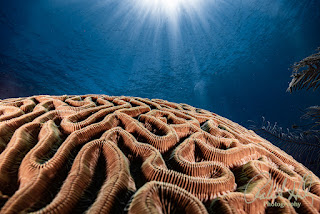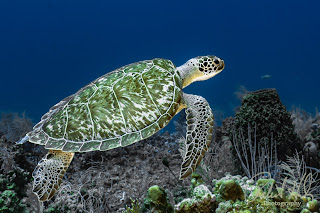Advanced Post-Processing Techniques Using Lightroom AI for Underwater Photography
 |
As previously discussed in previous blogs, underwater photography presents a unique set of challenges due to the varying light conditions, water clarity, and color distortions. Adobe Lightroom's AI-powered tools offer powerful solutions to address these challenges, making post-processing more efficient and effective. In this blog post, I will explore several advanced post-processing techniques using Lightroom AI, detailing each function, its application, and the expected results.
1. AI-Powered Auto Tone
Function Overview: Lightroom's AI-powered Auto Tone uses Adobe Sensei, an artificial intelligence framework, to analyze your photo and apply adjustments automatically.
Where to Use It: Auto Tone is best used as the first step in your post-processing workflow. It provides a solid starting point by balancing exposure, contrast, highlights, shadows, whites, and blacks.
Expected Results:
- Balanced exposure across the image
- Enhanced contrast and detail
- Corrected highlights and shadows for better overall lighting
2. AI-Driven Color Grading
Function Overview: The Color Grading tool in Lightroom allows for precise adjustments to the hue, saturation, and luminance of shadows, midtones, and highlights. The AI component helps suggest color schemes that can enhance the overall mood of the photo.
Where to Use It: Use Color Grading to add depth and mood to your underwater photos. It's particularly effective for accentuating the blues and greens typical in underwater scenes, or for creating a unique artistic look.
Expected Results:
- Enhanced color harmony
- Deeper and richer tones
- A more polished and professional appearance
3. AI-Based Selective Adjustments
Function Overview: Lightroom's AI-powered Selective Adjustments allow you to make precise changes to specific areas of your photo. Tools like the Adjustment Brush, Radial Filter, and Graduated Filter can be fine-tuned with AI to detect edges and textures.
Where to Use It: Use Selective Adjustments to brighten a subject, enhance details in specific areas, or correct color casts that might be affecting parts of your image. For underwater photos, this could mean highlighting a coral formation or a marine creature without affecting the background.
Expected Results:
- Improved subject isolation
- Enhanced details in key areas
- Balanced overall composition
4. AI-Enhanced Noise Reduction
Function Overview: Lightroom's AI-powered Noise Reduction intelligently reduces the graininess in your photos while preserving important details. This is crucial for underwater photography, where higher ISO settings are often used.
Where to Use It: Apply Noise Reduction to photos taken in low light or high ISO conditions. This is particularly useful for deep dives or night dives where natural light is limited.
Expected Results:
- Smoother images with less grain
- Retained details and sharpness
- A cleaner, more professional finish
5. AI-Powered Upright and Geometry
Function Overview: The Upright and Geometry tools use AI to correct distortions and align your photo perfectly. This includes correcting perspective distortions and ensuring straight lines appear straight.
Where to Use It: Use Upright and Geometry tools to correct lens distortions and perspective issues, especially when photographing shipwrecks, underwater structures, or any scene with significant lines.
Expected Results:
- Corrected perspective and alignment
- More accurate representation of the scene
- Enhanced compositional balance
6. AI-Driven Dehaze
Function Overview: The Dehaze tool, powered by AI, reduces haze and enhances the clarity of your photos. This is especially useful for underwater photography, where particles in the water can cause significant haze.
Where to Use It: Apply Dehaze to images with visibility issues caused by particulate matter in the water. This can dramatically improve the clarity and detail of your underwater shots.
Expected Results:
- Reduced haze and improved visibility
- Enhanced clarity and detail
- Brighter and more vivid images
7. AI-Enhanced Texture and Clarity
Function Overview: Texture and Clarity sliders, enhanced by AI, add definition and detail to your photos. Texture focuses on medium-sized details, while Clarity enhances mid-tone contrast.
Where to Use It: Use these tools to bring out details in marine life, coral, and underwater landscapes. They are especially useful for highlighting intricate textures and patterns.
Expected Results:
- Sharper details
- Enhanced texture and definition
- A more dynamic and engaging photo
8. AI Masking
Function Overview: AI Masking in Lightroom uses artificial intelligence to automatically select and mask different parts of your photo, such as subjects, skies, or backgrounds. This allows for more precise and efficient editing.
Where to Use It: Use AI Masking to apply adjustments to specific areas of your underwater photos without affecting the rest of the image. This can be especially useful for enhancing a subject, like a fish or coral, while leaving the water background untouched.
Expected Results:
- Accurate and precise masking
- Efficient selective editing
- Enhanced subject focus and detail without altering the background
9. AI Blur
Function Overview: The AI Blur tool in Lightroom uses artificial intelligence to intelligently blur parts of your image, helping to emphasize the main subject by creating a shallow depth of field effect. This can be particularly effective in underwater photography to draw attention to specific marine life or elements of the scene.
Where to Use It: Apply AI Blur to the background or less important elements of your underwater photos to make the main subject stand out. This is especially useful in cluttered scenes where you want to reduce distractions and focus the viewer’s attention.
Expected Results:
- Enhanced subject emphasis
- Reduced background distractions
- A professional, depth-of-field effect that highlights key elements
Constantly Expanding Capabilities
One of the most exciting aspects of Lightroom's AI functions is their constant evolution. Adobe regularly updates Lightroom, adding new AI capabilities and enhancing existing ones. This means that as a user, you will continuously gain access to more options and improved tools, allowing you to make your underwater photographs even more stunning. Staying updated with the latest versions of Lightroom ensures you can take full advantage of these advancements, keeping your post-processing techniques at the cutting edge of technology.
Conclusion
Underwater photographers can benefit from Adobe Lightroom's advanced AI-powered tools, which offer a range of powerful options for post-processing. These tools enable photographers to enhance their underwater photos by adjusting exposure, improving colors, and bringing out intricate details. Leveraging Lightroom's AI functionalities makes the entire process more intuitive and efficient, resulting in stunning visual masterpieces.
Experiment with these tools in your next post-processing session and witness the remarkable improvements in your underwater photography.
Stay Connected
Follow my blog for more tips and tutorials on underwater photography. Let's dive deeper into the art and craft of capturing the marine world!
Subscribe to my blog for more tips and tutorials on underwater photography. Don’t forget to share your processed photos on social media using the hashtag #RobertHerbPhotography. I look forward to reviewing your results.
New Online Training Program
I am excited to announce that I am creating an online training program to teach underwater hobbyists and enthusiasts how to enhance their photos using Adobe Lightroom. If you are interested in this training, please contact me at bob@robertherb.com to express your interest and to be notified about the details and start date of the classes.
Stay tuned and "Follow" for upcoming blogs on underwater photography tips and tricks for more in-depth insights. Please leave your comments and suggestions. Enjoy your diving and shooting experience!
I am eagerly anticipating your valuable feedback and suggestions.
Sincerely,
Bob Herb
|
|




Comments
Post a Comment
Please let me know your comments.